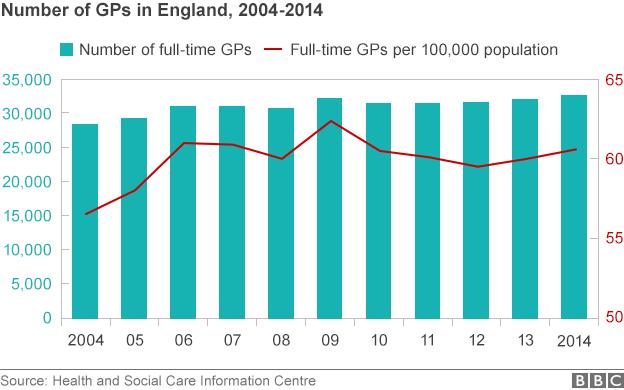Reality Check: Have GP services got worse?
- Published

Labour believes "GP services have gone backwards", citing a reduction in opening hours and longer waits to see a family doctor.
In a reworking of the Conservatives' "Labour isn't working" image of 1979, the party has launched a new election poster depicting a huge queue outside a waiting room with the title "The doctor can't see you now".
As evidence to back up his claims, Labour health spokesman Andy Burnham has pointed to figures obtained through a parliamentary question showing that the number of surgeries open on evenings and weekends had fallen from 77% to 72% in 2013-14.
Both the Conservatives and Liberal Democrats have said that the data is out-of-date, as it does not include the changes taking place under the Prime Minister's Challenge Fund - which is seeing one in eight practices starting to offer improved access.
In that, the coalition partners are right. But that does not mean Labour is wrong.

In terms of numbers of GPs working in England, the picture is complex.
Health and Social Care Information Centre data, external - released at the end of last month - showed that in 2009 there were 32,111 GPs once doctors in training and retainers, mainly retired GPs who do a few shifts, are excluded.
In 2014 that had risen by just over 500 to 32,628. A sign of improvement? Not quite.
If the population rise is factored in, the number of GPs per 100,000 people dropped from 62.4 to 60.6.
However, if you take 2010 as the starting point there is actually a marginal improvement, suggesting that the squeeze on GP care actually started under Labour.

Another way to look at GP care is obviously to consider waiting times - to which Mr Burnham alludes.
That is not so easy to gauge. Unlike hospital or A&E waiting, GP data is not tracked officially.
The best source of information is therefore the official GP survey carried out by Ipsos MORI for NHS England.
On a number of key measures, patient experiences have got worse. Some 85.2% rated their overall experience last year as good - down 2.4 percentage points since 2012.
Supply and demand
In particular, the ease with which people can get through to their surgery on the phone and the proportion of patients able to see or speak to someone when they last tried got worse.
On opening hours, 75.7% said they were satisfied with their surgery's opening hours - a drop of 4.8 percentage points since December 2012.
But statistics can only tell you so much. Talk to GPs and they will say that the ageing population means the complexity of illnesses that patients have is making care more difficult.
They say the number of visits made per patient is on the increase - in the past five years, the number of consultations overall is estimated to have increased by 70m to 370m a year.
That is why the Royal College of General Practitioners says that, regardless of what has happened to GP numbers, there are simply not enough. It believes there is a shortfall of around 3,000.
Like the rest of the NHS, demand is outstripping supply - even if there are signs that supply has increased.

Election 2015 - Reality Check

What's the truth behind the politicians' claims on the campaign trail? Our experts investigate the facts, and wider stories, behind the soundbites.
Read latest updates or follow us on Twitter @BBCRealityCheck, external
